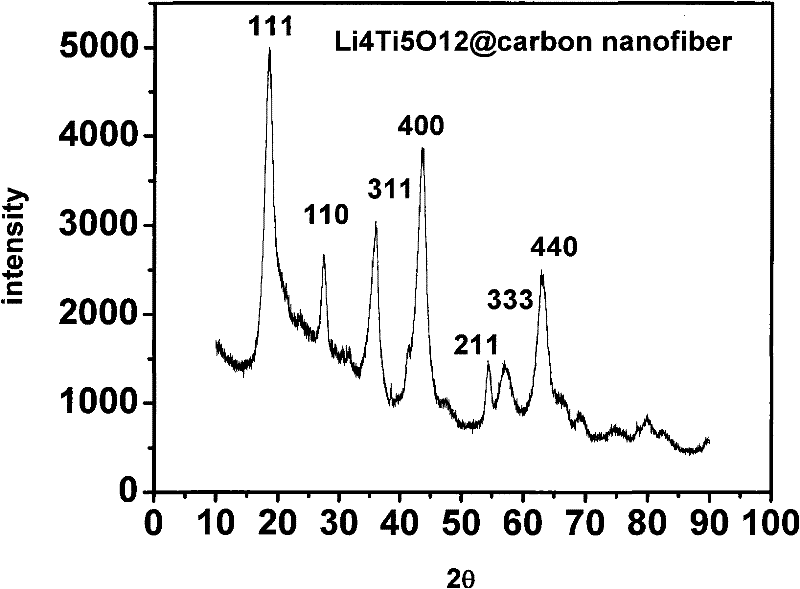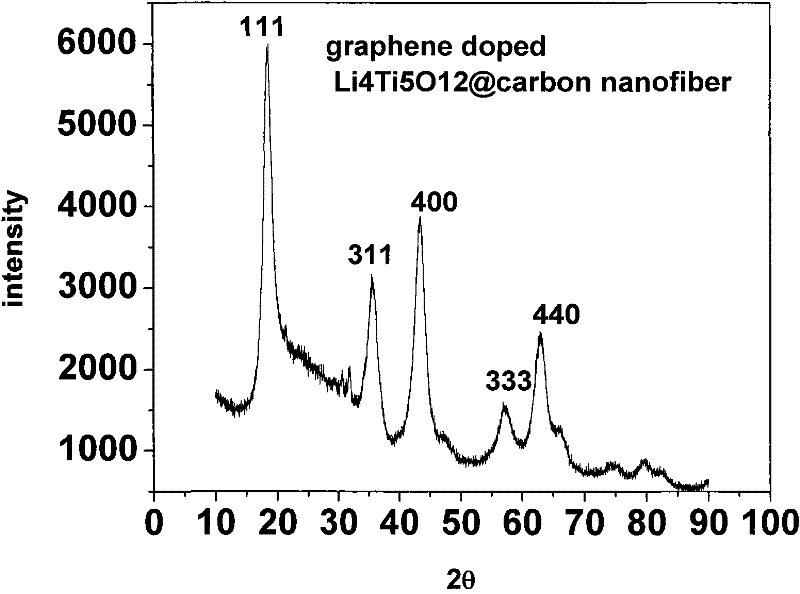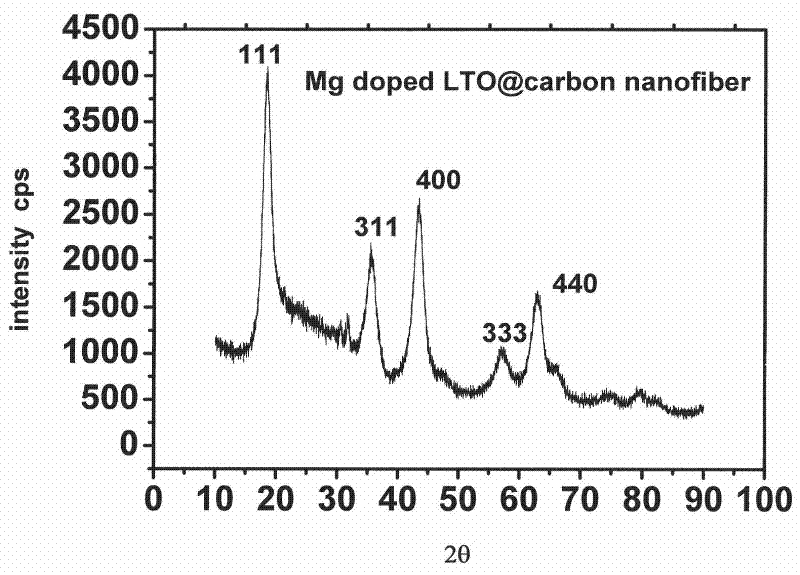Lithium titanate-carbon composite nano-material, preparation method thereof and application thereof
A nano-material, lithium titanate technology, applied in the field of lithium-ion batteries, can solve the problems of increased capacity attenuation, lower rate discharge capacity, and difficult continuous conductive network of lithium-ion batteries, achieving excellent high-current charge and discharge performance and less energy loss , good electrical conductivity
- Summary
- Abstract
- Description
- Claims
- Application Information
AI Technical Summary
Problems solved by technology
Method used
Image
Examples
Embodiment 1
[0042] Lithium isopropoxide and tetrabutyl titanate are mixed evenly according to the molar ratio of lithium element and titanium element being 4.4:5, and an ethanol solution of polyvinylpyrrolidone K90 is added, and ultrasonically dispersed to form a transparent sol, wherein polyvinylpyrrolidone K90 The dosage is 20% of the total mass of the sol. The prepared transparent sol was electrostatically spun into a film with a thickness of 0.2 mm at a rate of 12 mL / h at a DC voltage of 12.0 kV. Thin film precursors in N 2 Under atmospheric conditions, sinter at 500°C for 30 hours. After cooling, grind and sieve to obtain the lithium titanate-carbon composite nanofiber material provided by the present invention.
[0043] The aforementioned lithium titanate-carbon composite nanofiber material has a spinel structure. Adopt Cu target Kα radiation, λ=0.15406nm, obtain the X-ray diffraction pattern of this product, as figure 1 shown. pass Figure 4 The field emission scanning electr...
Embodiment 2
[0045] Lithium isopropoxide and tetraisopropyl titanate were uniformly mixed according to the molar ratio of lithium element to titanium element of 5.0:5, and polyaniline (M W 10000~100000) of N-methylpyrrolidone solution and graphene, ultrasonically dispersed to form a transparent sol, wherein the amount of polyaniline is 40% of the total mass of the sol, and the amount of graphene is 1% of the total mass of the sol. The prepared transparent sol was electrostatically spun into a film with a thickness of 0.2 mm at a rate of 2.0 mL / h under a DC voltage of 8.0 kV. Thin film precursors in N 2 Under atmospheric conditions, sinter at 900°C for 3 hours. After cooling, grind and sieve to obtain the lithium titanate-carbon composite nanofiber material provided by the present invention.
[0046] The aforementioned lithium titanate-carbon composite nanofiber material has a spinel structure. Adopt Cu target Kα radiation, λ=0.15406nm, obtain the X-ray diffraction pattern of this produc...
Embodiment 3
[0048] Lithium isopropoxide, titanium acetylacetonate and magnesium acetate are mixed evenly according to the molar ratio of lithium element, titanium element and magnesium element as 4:5:0.1, and polyacrylonitrile (M W 10000-100000) dimethyl sulfoxide solution, ultrasonically dispersed to form a transparent sol, wherein the amount of polyacrylonitrile is 10% of the total mass of the sol. The prepared transparent sol was electrostatically spun into a film with a thickness of 0.2 mm at a speed of 0.1 mL / h under a DC voltage of 15.0 kV. Thin film precursors in N 2 Under atmospheric conditions, sinter at 650°C for 10 hours. After cooling, grind and sieve to obtain the lithium titanate-carbon composite nanofiber material provided by the present invention.
[0049] The above-mentioned lithium titanate-carbon composite nanofiber material is a composite nanofiber material with a diameter of 100nm and a length of 2-5μm, and its X-ray diffraction diagram and transmission electron mic...
PUM
| Property | Measurement | Unit |
|---|---|---|
| Dimension diameter | aaaaa | aaaaa |
| Length | aaaaa | aaaaa |
| Fiber diameter | aaaaa | aaaaa |
Abstract
Description
Claims
Application Information
 Login to View More
Login to View More - R&D
- Intellectual Property
- Life Sciences
- Materials
- Tech Scout
- Unparalleled Data Quality
- Higher Quality Content
- 60% Fewer Hallucinations
Browse by: Latest US Patents, China's latest patents, Technical Efficacy Thesaurus, Application Domain, Technology Topic, Popular Technical Reports.
© 2025 PatSnap. All rights reserved.Legal|Privacy policy|Modern Slavery Act Transparency Statement|Sitemap|About US| Contact US: help@patsnap.com



